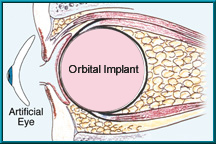Orbital implants & artificial eyes
Orbital implants and artificial eyes
When an eye is removed, an orbital implant is used to replace the area in the orbit (bony cavity) that was occupied by the eye. This small, spherical implant maintains the natural structure of the orbit and provides support for the artificial eye. However, the implant itself is not visible.

Figure 1. Orbital implant with artificial eye (shown removed)
An artificial eye is used to restore the natural appearance of the eye and surrounding tissues, and is the visible part of the surgical changes to the socket (Fig. 1). Artificial eyes are usually made of plastic (acrylic) or glass. Custom artificial eyes are hand-crafted by highly skilled ocularists (eye makers) to precisely match the look of the natural eye.
While artificial eyes have been made for thousands of years, the first orbital implants were developed about 100 years ago. These small spheres of glass or gold were later replaced by plastic or silicone spheres; but until recently, the basic design of these “first-generation” implants had changed little over the years.
The need for a better implant
The first-generation implants were a major improvement for those wearing an artificial eye, but they were unable to deliver natural movement to the artificial eye.
This lack of movement was a major obstacle to restoring a natural appearance, which made the adjustment to wearing an artificial eye much more difficult.
The first-generation implants also tended to drift (migrate) in the orbit and were often rejected (extruded) by the tissues of the body, making further surgeries necessary. These problems inspired researchers to search for a better orbital implant.
Next
Hydroxyapatite

